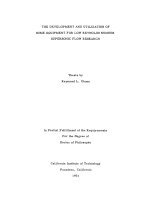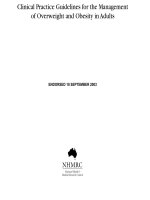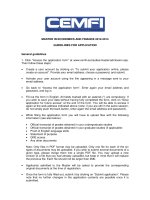Basic math and pre algebra practice problems for dummies
Bạn đang xem bản rút gọn của tài liệu. Xem và tải ngay bản đầy đủ của tài liệu tại đây (7.88 MB, 397 trang )
Mantesh
Published by
John Wiley & Sons, Inc.
111 River St.
Hoboken, NJ 07030-5774
www.wiley.com
Copyright © 2013 by John Wiley & Sons, Inc., Hoboken, New Jersey
Published by John Wiley & Sons, Inc., Hoboken, New Jersey
Published simultaneously in Canada
No part of this publication may be reproduced, stored in a retrieval system or transmitted in
any form or by any means, electronic, mechanical, photocopying, recording, scanning or
otherwise, except as permitted under Sections 107 or 108 of the 1976 United States
Copyright Act, without the prior written permission of the Publisher. Requests to the
Publisher for permission should be addressed to the Permissions Department, John Wiley
& Sons, Inc., 111 River Street, Hoboken, NJ 07030, (201) 748-6011, fax (201) 748-6008,
or online at />Trademarks: Wiley, the Wiley logo, For Dummies, the Dummies Man logo, A Reference
for the Rest of Us!, The Dummies Way, Dummies Daily, The Fun and Easy Way,
Dummies.com, Making Everything Easier, and related trade dress are trademarks or
registered trademarks of John Wiley & Sons, Inc., and/or its affiliates in the United States
and other countries, and may not be used without written permission. All other trademarks
are the property of their respective owners. John Wiley & Sons, Inc., is not associated with
any product or vendor mentioned in this book.
Limit of Liability/Disclaimer of Warranty: The publisher and the author make no
representations or warranties with respect to the accuracy or completeness of the contents
of this work and specifically disclaim all warranties, including without limitation
warranties of fitness for a particular purpose. No warranty may be created or extended by
sales or promotional materials. The advice and strategies contained herein may not be
suitable for every situation. This work is sold with the understanding that the publisher is
not engaged in rendering legal, accounting, or other professional services. If professional
assistance is required, the services of a competent professional person should be sought.
Neither the publisher nor the author shall be liable for damages arising herefrom. The fact
that an organization or Website is referred to in this work as a citation and/or a potential
source of further information does not mean that the author or the publisher endorses the
information the organization or Website may provide or recommendations it may make.
Further, readers should be aware that Internet Websites listed in this work may have
changed or disappeared between when this work was written and when it is read.
For general information on our other products and services, please contact our Customer
Care Department within the U.S. at 877-762-2974, outside the U.S. at 317-572-3993, or fax
317-572-4002.
For technical support, please visit www.wiley.com/techsupport.
Wiley publishes in a variety of print and electronic formats and by print-on-demand. Some
material included with standard print versions of this book may not be included in e-books
or in print-on-demand. If this book refers to media such as a CD or DVD that is not
included in the version you purchased, you may download this material at
. For more information about Wiley products, visit
www.wiley.com.
Library of Congress Control Number: 2013932103
ISBN 978-1-118-44656-0 (pbk); ISBN 978-1-118-44645-4 (ebk); ISBN 978-1-11844653-9 (ebk); ISBN 978-1-118-44654-6 (ebk)
Manufactured in the United States of America
10 9 8 7 6 5 4 3 2 1
About the Author
Mark Zegarelli is the author of Basic Math & Pre-Algebra For Dummies, Calculus II For
Dummies, and five other books on math, logic, and test preparation. He holds degrees in
both English and math from Rutgers University and is a math tutor and teacher.
Mark lives in San Francisco, California, and Long Branch, New Jersey.
Dedication
This is for Suleiman.
Author’s Acknowledgments
This is my eighth For Dummies book and, as always, the experience of writing it has been
productive and fun. Thanks so much to editors Tim Gallan, Christy Pingleton, Lindsay
Lefevere, Shira Fass, and Suzanne Langebartels for setting me right as needed.
And thanks to the folks at Borderlands Café on Valencia Street in San Francisco for the
friendly, peaceful, and caffeine-accessible environment that virtually any writer (this one,
for example) would find conducive to putting actual words on paper.
Publisher’s Acknowledgments
We’re proud of this book; please send us your comments at .
For other comments, please contact our Customer Care Department within the U.S. at 877762-2974, outside the U.S. at 317-572-3993, or fax 317-572-4002.
Some of the people who helped bring this book to market include the following:
Acquisitions, Editorial, and Vertical Websites
Senior Project Editor: Tim Gallan
Executive Editor: Lindsay Sandman Lefevere
Copy Editors: Suzanne Langebartels, Christine Pingleton
Assistant Editor: David Lutton
Editorial Program Coordinator: Joe Niesen
Technical Editor: Shira Fass
Editorial Manager: Michelle Hacker
Editorial Assistants: Rachelle S. Amick, Alexa Koschier
Cover Photos: © Sandra van der Steen/iStockphoto.com
Composition Services
Senior Project Coordinator: Kristie Rees
Layout and Graphics: Carrie A. Cesavice, Shawn Frazier, Erin Zeltner
Proofreaders: Jacqui Brownstein, Dwight Ramsey
Indexer: Potomac Indexing, LLC
Publishing and Editorial for Consumer Dummies
Kathleen Nebenhaus, Vice President and Executive Publisher
David Palmer, Associate Publisher
Kristin Ferguson-Wagstaffe, Product Development Director
Publishing for Technology Dummies
Andy Cummings, Vice President and Publisher
Composition Services
Debbie Stailey, Director of Composition Services
1,001
Basic
Math
&
Problems For Dummies®
Pre-Algebra
Practice
Visit www.dummies.com/cheatsheet/1001basicmath&pre-algebra to view this book's
cheat sheet.
Table of Contents
Introduction
What You’ll Find
How This Workbook Is Organized
Part I: Questions
Part II: Answers
Beyond the Book
What you’ll find online
How to register
Where to Go for Additional Help
Part I: The Questions
Chapter 1: The Big Four Operations
The Problems You’ll Work On
What to Watch Out For
Chapter 2: Less than Zero: Working with Negative Numbers
The Problems You’ll Work On
What to Watch Out For
Chapter 3: You’ve Got the Power: Powers and Roots
The Problems You’ll Work On
What to Watch Out For
Chapter 4: Following Orders: Order of Operations
The Problems You’ll Work On
What to Watch Out For
Mantesh
Chapter 5: Big Four Word Problems
The Problems You’ll Work On
What to Watch Out For
Chapter 6: Divided We Stand
The Problems You’ll Work On
What to Watch Out For
Chapter 7: Factors and Multiples
The Problems You’ll Work On
What to Watch Out For
Chapter 8: Word Problems about Factors and Multiples
The Problems You’ll Work On
What to Watch Out For
Chapter 9: Fractions
The Problems You’ll Work On
What to Watch Out For
Chapter 10: Decimals
The Problems You’ll Work On
What to Watch Out For
Chapter 11: Percents
The Problems You’ll Work On
What to Watch Out For
Chapter 12: Ratios and Proportions
The Problems You’ll Work On
What to Watch Out For
Chapter 13: Word Problems for Fractions, Decimals, and Percents
The Problems You’ll Work On
What to Watch Out For
Mantesh
Chapter 14: Scientific Notation
The Problems You’ll Work On
What to Watch Out For
Chapter 15: Weights and Measures
The Problems You’ll Work On
What to Watch Out For
Chapter 16: Geometry
The Problems You’ll Work On
What to Watch Out For
Chapter 17: Graphing
The Problems You’ll Work On
What to Watch Out For
Chapter 18: Statistics and Probability
The Problems You’ll Work On
What to Watch Out For
Chapter 19: Set Theory
The Problems You’ll Work On
What to Watch Out For
Chapter 20: Algebraic Expressions
The Problems You’ll Work On
What to Watch Out For
Chapter 21: Solving Algebraic Equations
The Problems You’ll Work On
What to Watch Out For
Chapter 22: Solving Algebra Word Problems
The Problems You’ll Work On
What to Watch Out For
Mantesh
Part II: The Answers
Chapter 23: Answers
Answers 1 - 100
Answers 101 - 200
Answers 201 - 300
Answers 301 - 400
Answers 401 - 500
Answers 501 - 600
Answers 601 - 700
Answers 701 - 800
Answers 801 - 900
Answers 901 - 1001
Cheat Sheet
Introduction
Are you kidding . . . 1,001 math problems, really?
That’s right, a thousand questions plus one to grow on, here in your hot little hands. I’ve
arranged them in order, starting with beginning arithmetic and ending with basic algebra.
Topics include everything from the Big Four operations (adding, subtracting, multiplying,
and dividing), through negative numbers and fractions, on to geometry and probability, and
finally algebra — plus lots more!
Every chapter provides tips for solving the problems in that chapter. And, of course, the
back of the book includes detailed explanations of the answers to every question.
It’s all here, so get to work!
What You’ll Find
This book includes 1,001 basic math and pre-algebra problems, divided into 22 chapters.
Each chapter contains problems focusing on a single math topic, such as negative numbers,
fractions, or geometry.
Within each chapter, topics are broken into subtopics so that you can work on a specific
type of math skill until you feel confident with it. Generally speaking, each section starts
with easy problems, moves on to medium ones, and then finishes with hard problems.
You can jump right in anywhere you like and solve these problems in any order. You can
also take on one chapter or section at a time, working from easy to medium to hard
problems. Or, if you like, you can begin with Question #1 and move right through to
Question #1,001.
Additionally, each chapter begins with a list of tips for answering the questions in that
chapter.
Every question in Part I is answered in Part II, with a full explanation that walks you
through how to understand, set up, and solve the problem.
How This Workbook Is Organized
This workbook includes 1,001 questions in Part I and answers to all of these questions in
Part II.
Part I: Questions
Here are the topics covered by the 1,001 questions in this book:
Basic arithmetic: In Chapters 1 through 5, you find dozens of basic arithmetic
problems. Chapter 1 begins with rounding numbers and then moves on to basic calculating
with addition, subtraction, multiplication, and division. Then, in Chapter 2, you tackle
negative numbers, and in Chapter 3, you move on to working with powers and square roots.
Chapter 4 gives you plenty of practice in solving arithmetic problems using the order of
operations. You may remember this using the mnemonic PEMDAS — Parentheses,
Exponents, Multiplication and Division, Addition and Subtraction.
Finally, in Chapter 5, you put all of this information together to answer arithmetic
word problems, from easy to challenging.
Divisibility, factors, and multiples: Chapters 6, 7, and 8 cover a set of topics related to
divisibility. In Chapter 6, you discover a variety of divisibility tricks, which allow you to
find out whether a number is divisible by another without actually doing the division. You
also work with division with remainders and understand the distinction between prime and
composite numbers.
Chapter 7 focuses on factors and multiples. You discover how to generate all the
factors and prime factors of a number and calculate the greatest common factor (GCF)
for a set of two or more numbers. Additionally, you generate a partial list of the
multiples, and calculate the least common multiple (LCM) of two or more numbers.
Chapter 8 wraps up the section with word problems that sharpen and extend your
skills working with factors, multiples, remainders, and prime numbers.
Fractions, decimals, percents, and ratios: Chapters 9 through 13 focus on four distinct
ways to represent parts of a whole — fractions, decimals, percents, and ratios. In Chapter
9, you work with fractions, including increasing the terms of fractions and reducing them to
lowest terms. You change improper fractions to mixed numbers, and vice versa. You add,
subtract, multiply, and divide fractions, including mixed numbers. You also simplify
complex fractions.
In Chapter 10, you convert fractions to decimals, and vice versa. You add, subtract,
multiply, and divide decimals. You also find out how to work with repeating
decimals. Chapter 11 focuses on percents. You convert fractions and multiples to
percents, and vice versa. You discover a few tricks for calculating simple percents.
You also work on more difficult percent problems by creating word equations, which
can then be translated into equations and solved.
Chapter 12 presents a variety of problems, including word problems, that use ratios
and proportions. And in Chapter 13, you tackle even more word problems where you
apply your skills working with fractions, decimals, and percents.
Scientific notation, weights and measures, geometry, graphs, statistics and
probability, and sets: In Chapters 14 through 19, you take a great stride forward working
with a wide variety of intermediate basic math skills. In Chapter 14, the topic is scientific
notation, which is used to represent very large and very small numbers. Chapter 15
introduces you to weights and measures, focusing on the English and metric systems, and
conversions between the two. Chapter 16 gives you a huge number of geometry problems of
every description, including both plane and solid geometry. In Chapter 17, you work with a
variety of graphs, including bar graphs, pie charts, line graphs, pictographs, and the xygraph that is used so much in algebra and later math.
Chapter 18 gives you an introduction to basic statistics, including the mean, median,
and mode. It also provides problems in probability and gives you an introduction to
counting both independent and dependent events. Chapter 19 gives you some problems
in basic set theory, including finding the union, intersection, relative complement, and
complement. Additionally, you use Venn diagrams to solve word problems.
Algebraic expressions and equations: To finish up, Chapters 20, 21, and 22 give you a
taste of the work you’ll be doing in your first algebra class. Chapter 20 shows you the
basics of working with algebraic expressions, including evaluating, simplifying, and
factoring. In Chapter 21, you solve basic algebraic equations. And in Chapter 22, you put
these skills to use, solving a set of word problems with basic algebra.
Part II: Answers
In this part, you find answers to all 1,001 questions that appear in Part I. Each answer
contains a complete step-by-step explanation of how to solve the problem from beginning
to end.
Beyond the Book
This book gives you plenty of math to work on and prepares you for algebra. But maybe you
want to track your progress as you tackle the problems, or maybe you’re having trouble
with certain types of problems and wish they were all presented in one place where you
could methodically make your way through them. You’re in luck. Your book purchase
comes with a free one-year subscription to all 1,001 practice problems online. You get onthe-go access any way you want it — from your computer, smartphone, or tablet. Track
your progress and view personalized reports that show where you need to study the most.
And then do it. Study what, where, when, and how you want.
What you’ll find online
The online practice that comes free with this book offers you the same 1,001 questions and
answers that are available here, presented in a multiple-choice format. The beauty of the
online problems is that you can customize your online practice to focus on the topic areas
that give you the most trouble. So if you need help converting fractions to decimals or have
trouble grasping pre-algebra, then select these problem types online and start practicing.
Or, if you’re short on time but want to get a mixed bag of a limited number of problems, you
can specify the quantity of problems you want to practice. Whether you practice a few
hundred problems in one sitting or a couple dozen, and whether you focus on a few types of
problems or practice every type, the online program keeps track of the questions you get
right and wrong so that you can monitor your progress and spend time studying exactly what
you need.
You can access this online tool using a PIN code, as described in the next section. Keep in
mind that you can create only one login with your PIN. Once the PIN is used, it’s no longer
valid and is nontransferable. So you can’t share your PIN with other users after you’ve
established your login credentials.
How to register
Purchasing this book entitles you to one year of free access to the online, multiple-choice
version of all 1,001 of this book’s practice problems. All you have to do is register. Just
follow these simple steps:
1. Find your PIN code.
• Print book users: If you purchased a hard copy of this book, turn to the back of this
book to find your PIN.
• E-book users: If you purchased this book as an e-book, you can get your PIN by
registering your e-book at dummies.com/go/getaccess. Go to this website, find your
book and click it, and then answer the security question to verify your purchase. Then
you’ll receive an e-mail with your PIN.
2. Go to onlinepractice.dummies.com.
3. Enter your PIN.
4. Follow the instructions to create an account and establish your own login
information.
That’s all there is to it! You can come back to the online program again and again — simply
log in with the username and password you choose during your initial login. No need to use
the PIN a second time.
If you have trouble with the PIN or can’t find it, please contact Wiley Product Technical
Support at 800-762-2974 or .
Your registration is good for one year from the day you activate your PIN. After that
time frame has passed, you can renew your registration for a fee. The website gives you all the
important details about how to do so.
Where to Go for Additional Help
Every chapter in this book opens with tips for solving the problems in that chapter. And, of
course, if you get stuck on any question, you can flip to the answer section and try to work
through the solution provided. However, if you feel that you need a bit more basic math
information than this book provides, I highly recommend my earlier book Basic Math &
Pre-Algebra For Dummies. This book gives you a ton of useful information for solving
every type of problem included here.
Additionally, you can also check out my Basic Math & Pre-Algebra Workbook For
Dummies. It contains a nice mix of short explanations for how to do various types of
problems, followed by practice. And, for a quick take on the most important basic math
concepts, have a look at Basic Math & Pre-Algebra Essentials For Dummies. Yep, I
wrote that one, too — how’s that for shameless plugs?
Part I
The Questions
Visit www.dummies.com for great Dummies content online
In this part . . .
One thousand and one math problems. That’s one problem for every night in the Arabian
Nights stories. That’s almost ten problems for every floor in the Empire State Building. In
short, that’s a lot of problems — plenty of practice to help you attain the math skills you
need to do well in your current math class. Here’s an overview of the types of questions
provided:
Basic arithmetic, including absolute value, negative numbers, powers, and square roots
(Chapters 1 through 5)
Divisibility, factors, and multiples (Chapters 6 through 8)
Fractions, decimals, percents, and ratios (Chapters 9 through 13)
Scientific notation, measures, geometry, graphs, statistics, probability, and sets
(Chapters 14 through 19)
Algebraic expressions and equations (Chapters 20 through 22)
Chapter 1
The Big Four Operations
The Big Four operations (adding, subtracting, multiplying, and dividing) are the basis for
all of arithmetic. In this chapter, you get plenty of practice working with these important
operations.
The Problems You’ll Work On
Here are the types of problems you find in this chapter:
Rounding numbers to the nearest ten, hundred, thousand, or million
Adding columns of figures, including addition with carrying
Subtracting one number from another, including subtraction with borrowing
Multiplying one number by another
Division, including division with a remainder
What to Watch Out For
Here’s a quick tip for rounding numbers to help you in this chapter: When rounding a
number, check the number to the right of the place you’re rounding to. If that number is from
0 to 4, round down by changing that number to 0. If that number is from 5 to 9, round up by
changing that number to 0 and adding 1 to the number to its left.
For example, to round 7,654 to the nearest hundred, check the number to the right of the
hundreds place. That number is 5, so change it to 0 and add 1 to the 6 that’s to the left of it.
Thus, 7,654 becomes 7,700.
Rounding
1–6
1. Round the number 136 to the nearest ten.
2. Round the number 224 to the nearest ten.
3. Round the number 2,492 to the nearest hundred.
4. Round the number 909,090 to the nearest hundred.
5. Round the number 9,099 to the nearest thousand.
6. Round the number 234,567,890 to the nearest million.
Adding, Subtracting, Multiplying, and Dividing
7–30
7. Add 47 + 21 = ?
8. Add 136 + 53 + 77 = ?
9. Add 735 + 246 + 1,329 = ?
10. Add 904 + 1,024 + 6,532 + 883 = ?
11. Add 56,702 + 821 + 5,332 + 89 + 343,111 = ?
12. Add 1,609,432 + 657,936 + 82,844 + 2,579 + 459 = ?
13. Subtract 89 – 54 = ?
14. Subtract 373 – 52 = ?
15. Subtract 539 – 367 = ?
16. Subtract 2,468 – 291 = ?
17. Subtract 34,825 – 26,492 = ?
18. Subtract 71,002 – 56,234 = ?
19. Multiply
20. Multiply
21. Multiply
22. Multiply
23. Multiply
24. Multiply
25. Divide
26. Divide
27. Divide
28. Divide
29. Divide
30. Divide
Chapter 2
Less than Zero: Working with Negative Numbers
Negative numbers can be a cause of negativity for some students. The rules for working
with negative numbers can be a little tricky. In this chapter, you practice applying the Big
Four operations to negative numbers. You also strengthen your skills evaluating absolute
value.
The Problems You’ll Work On
This chapter shows you how to work with the following types of problems:
Subtracting a smaller number minus a larger number
Adding and subtracting with negative numbers
Multiplying and dividing with negative numbers
Evaluating absolute value
What to Watch Out For
Here are a few things to keep an eye out for when you’re working with negative numbers:
To subtract a smaller number minus a larger number, reverse and negate: Reverse by
subtracting the larger number minus the smaller one, and then negate by attaching a minus
sign (–) in front of the result. For example, 4 – 7 = –3.
To subtract a negative number minus a positive number, add and negate: Add the two
numbers as if they were positive, then negate by attaching a minus sign in front of the result.
For example, –5 – 4 = –9.
To add a positive number and a negative number (in either order), subtract the larger
number minus the smaller number; then attach the same sign to the result as the number that
is farther from 0. For example, –3 + 5 = 2 and 4 + (–6) = –2.
Adding and Subtracting Negative Numbers
31–41
31. Evaluate each of the following.
i.
ii.
iii.
iv.
v.
32. Evaluate each of the following.
i.
ii.
iii.
iv.
v.
33. Evaluate each of the following.
i.
ii.
iii.
iv.
v.
34. Evaluate each of the following.
i.
ii.
iii.
iv.
v.
35. Evaluate each of the following.
i.
ii.
iii.
iv.
v.
36.
37.
38.
39.
40.
41.
Multiplying and Dividing Negative Numbers
42–53
42. Evaluate each of the following.
i.
ii.
iii.
iv.
v.
43.
44.
Mantesh
45.
46.
47.
48.
49. Evaluate each of the following.
i.
ii.
iii.
iv.
v.
50.
51.
52.
53.
Working with Absolute Value
54–57
54. Evaluate each of the following.
i.
ii.









